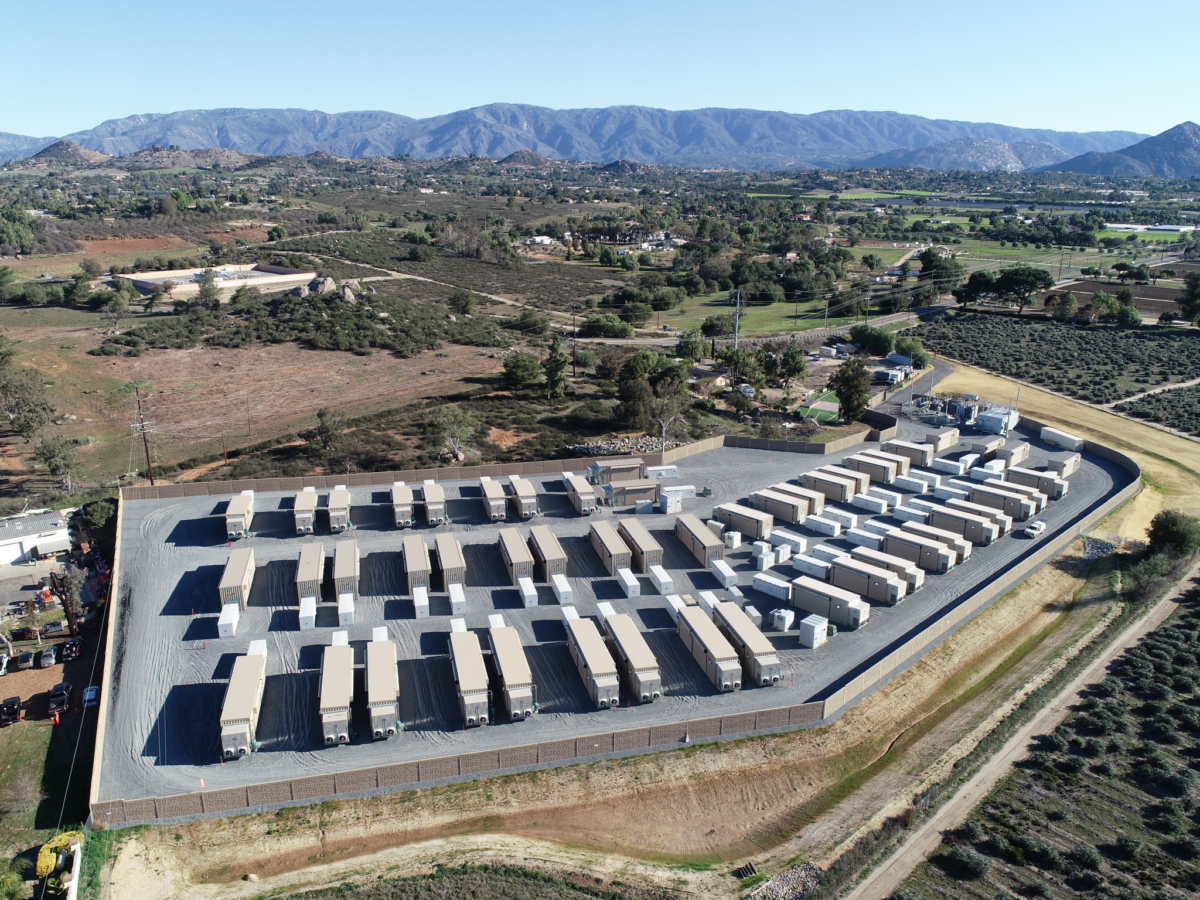A fire erupted on Monday inside a solar battery storage container at the Valley Center Energy Storage Facility in northern San Diego County, California.
The fire occurred when a battery storage unit caught fire, according to Terra-Gen, owner of the energy storage facility.
The Valley Center Energy Storage Facility is a stand-alone 139 MW energy storage project located on a 7-acre property within a commercial-industrial zone. Homes and businesses within a quarter mile of the site were evacuated and a shelter-in-place order was in effect for anyone a half mile from the site. Terra-Gen issued a statement saying that the facility’s design systems are keeping the incident contained.
The energy storage facility houses lithium nickel manganese cobalt oxide (NMC) in racks within enclosures. Electricity is stored and discharged from the batteries to the inverter transformer located next to them, which converts the energy from DC to AC. The energy is delivered to the SDG&E Valley Center substation located one-third of a mile away. Terra-Gen contracted with San Diego Gas & Electric (SDG&E) to provide power under a 15-year Resource Adequacy (RA) contract for up to 14,000 homes for four hours on a single charge..
Lithium NMC batteries have been known to cause fires, explosions, arc flashes, electric shocks from the energy storage systems can expose workers and area residents to toxic chemicals. The McMicken fire is an often cited incident that occurred in 2019 in Arizona when an Arizona Public Service (APS) battery failure and corresponding explosion left eight firefighters and one police officer hospitalized. Insights from that fire are reflected in the 2023 National Fire Protection Association (NFPA) 855 code revision. American Clean Power recently published a guide for first responders on lithium-ion battery energy storage system emergencies that takes the new code into account.
The Valley Center facility has been online since March 2022, and this is reportedly the second fire at the location. The first occurred in March of this year when a faulty sprinkler system caused the decommissioning of LG batteries.
The California Public Utilities Commission recently approved a plan to add more than 25.5 GW of renewables and 15 GW of storage by 2032, at a cost of $49 billion. The purpose of ramping up battery energy storage is to prevent power outages, help stabilize the grid, and help with peak power demand, all especially important in an area prone to high heat and wildfires. SDG&E is reportedly nearing approximately 300 MW of its own energy storage and Pacific Gas & Electric is also moving quickly to ramp up its battery resources.
According to Terra-Gen, the Valley Center project also provided economic benefits amounting to tens of millions of dollars in the form of direct and indirect jobs associated during construction and increased property taxes. In addition, the company donated $250,000 to support the Valley Center Fire Protection District’s new fire station.
Terra-Gen reports that it owns and operates four battery energy storage projects in California, representing over 1.5 GW of energy storage, or enough to power 1.5 million homes for approximately 4 hours. The company has an additional 1 GW under construction, expected to come on-line in 2025.
This article was amended on Sept. 20, 2023 to add the nickel manganese cobalt oxide battery chemistry.
This content is protected by copyright and may not be reused. If you want to cooperate with us and would like to reuse some of our content, please contact: editors@pv-magazine.com.









Eventually, the lithium in these stationary storage batteries will probably be recycled for vehicular use, where weight is a primary consideration. Many large lithium stationary battery installations like this will be replaced with cheaper, modular, non-flammable storage batteries like zinc bromine that are much better suited for these applications. This will be especially true for widely distributed neighborhood micro grid locations consisting of solar parking lot canopies +stationary batteries +Vehicle-2-Grid chargers shading acres of ridiculously under-utilized (sub)urban hot asphalt parking lots, right where most energy is being consumed. No new land acquisition, site improvements or utility monopoly transmission required.
These storage facilities need to be using redux flow batteries. They take more room, but no fire or explosion worries.
Please learn the difference between power, measured in Watts, and energy measured in Watt-hours. The energy storage capacity of a battery, no matter how small or large is measured in Watt-hours or a multiple thereof, for instance a 50 MW-h battery is able to store 50 million Watt-hours of energy. The battery also is rated for maximum power, so in this example, it might be rated at 20 MW, meaning it can supply a maximum of 20 million Watts of power to the grid. The point here is that Watts alone, without the accompanying hours doesn’t say anything at all about the storage capacity of the battery. Both power and storage capacity specifications are important and distinct from one another.
The official SI unit of energy is the Joule, which is one Watt-second, but the Joule is not normally used when speaking of power and energy because it is an inconveniently small unit for anything other than small amounts of energy.